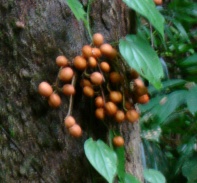Plants have a fascinating array of adaptations that function to maximise the odds of successful reproduction. Flamboyantly shaped & coloured flowers spring to mind, not to mention nectar rewards & attractive scents (which are not necessarily pleasant to the human nose, but then, Rafflesia isn’t out to attract us!). One of the more unusual adaptations is cauliflory – the flowers are produced on the main trunk or branches of the plant, rather than on a separate flower stem. (Ironically, cauliflower is not an example of a cauliflorous plant. That tightly bunched white head – so yummy with a nice tasty cheese sauce – is derived from a ‘normal’ flower, borne like a lily, orchid or rose on a young leafy stem that develops from an apical or axillary bud.)
I hadn’t come across cauliflory until our trip to the Daintree while on holiday. (Either I didn’t learn about it way back when, or the information fell out the back of my head once exams were over…) Our guide drew everyone’s attention to this tree, a red mahogany:

Those red-gold balls on the trunk are the fruits of this particular species, produced from fertilised flowers that were held on short stalks just above the bark.

How would this particular adaptation have evolved? After all, ‘typical’ flowers are held out there where they can be easily found by pollinators (or, if they’re wind-pollinated, their anthers hang out there in the breeze). But this ignores the fact that many animals live on the tree trunks themselves – the Boyd’s forest dragon I wrote about earlier is just one example. The ‘stem flowers’ of cauliflorous plants are easily accessible to any animal moving about on the trunks below the forest canopy, & this type of flower turns out to be relatively common among rainforest trees, where mammals, birds, reptiles & insects all act as their pollinators. Around 100 different species are cauliflorous, something which seems to have evolved on more than one occasion as it’s found in many different plant families in the tropics (caulifory is less common in temperate-zone plants).
So – something else to add to my lectures this year 🙂 And hopefully my students will absorb the information better than I did!
herr doktor bimler says:
Perhaps your students would pay more attention if you invoked a more relevant example, that of Theobroma cacao, without which we would not have chocolate.
Or just threaten to feed them Brussels sprouts.